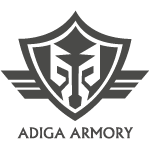
This is the first installment in a multi-part sighting techniques tutorial. This section is intended to help give some visual aid to new shooters, or to those who are teaching someone else to shoot. The goal here is to give viewers a better understanding of a correct sight picture, and to point out some potential pitfalls to avoid…
The image above describes a correct sight picture for standard, aimed shooting (we’ll cover point shooting in upcoming chapters of this series). Close your “weak” eye and use your dominant eye to focus on the front sight. This will leave the rear sight and the target slightly blurry. As you press the trigger to the rear, make sure the sights stay aligned for the entire duration of the pull. As the trigger breaks and the cartridge fires, maintain your focus on the front sight so you can quickly realign for your next shot.
If you do not align the sights properly, the following results will occur…

Front sight is too high… correct high impact points by lowering the front sight so it is on the same plane as the rear sight.

Front sight is too low… correct low impact points by raising the front sight so it is on the same plane as the rear sight.

Front sight is too far to the left… correct this by centering your front sight in the middle of the rear sight notch.

Front sight is too far to the right… correct this by centering your front sight in the middle of the rear sight notch.
DRY PRACTICE MAKES PERFECT
The best way to learn proper sighting technique is with some dry practice. First, make sure your gun is unloaded, and remove all live ammo from the immediate area. Find yourself a safe place to aim, such as a thick external wall made of bricks and/or concrete, the side of a bookshelf full of books, or into a thick earthen berm. Next, choose a target in the safe area to take aim at (note: your neighbors cat is not a feasible target). Now begin practicing with some slow, smooth trigger pulls while maintaining a proper sight picture. Make sure you are not flinching or otherwise moving the gun before, during or after the trigger breaks.
Dry practice as often as you have time to. I usually do it for about 15-20 minutes per session, 2 or 3 times per week. Dry practice is a crucial exercise for developing your accuracy… perhaps even more so than actual shooting. Without the concussive recoil of live fire practice, you will be able to see and correct your mistakes much easier. Once you get used to maintaining your sight picture throughout the trigger cycling process, you will be making bullseye hits like a pro. So keep up the good work, happy shooting and stay safe.

This is the best training aid I have used for instructing young shooters. Able to show the sight picture to them. It has more of an impact to them by seeing. Grip and hold can be practiced and improved on. Getting the sight picture in the head is a big problem.
I was always told not to dry fire any guns. Has this philosophy changed?
Can you include site pictures for firearms with peep sites?
I am still not 100% on the site picture for a peep site.. Thanks
We have a video on peep sight picture here: https://youtu.be/NA9K0O32huU
By far my favorite blog on shooting so far. Many many thanks…I’ve a question regarding aimed shooting. I’ve often been told keep BOTH eyes open and focus on the front sight. Easier said than done. What I’m seeing is TWO rear sights, and TWO targets. As a right-eye dominant shooter, I use the left set of gun sights and aim the front sight at the target image on the right. I’d like to know your thoughts on Aimed Shooting with both eyes open. Again, many thanks!
Great tutorial. I salute you guys…
Excellent! Very helpful to me, a new shooter….
KPB,
Excellent points… perhaps a segment on grip/trigger form would be a nice installment in the future. Thanks for chiming in.
Greetings,
Both articles – Aimed and Point Shooting carry very useful, practical information. I would like only to add the importance of the grip technique. Appropriate grip, including the placement of the strong hand’s web, contributes not only to more accurate and consistent aiming but also to the reliability of the cycling especially in the case of the semi-autos.
Thanks again for the excellent tutorials.
KPB
PS Dry-practice is indispensible!